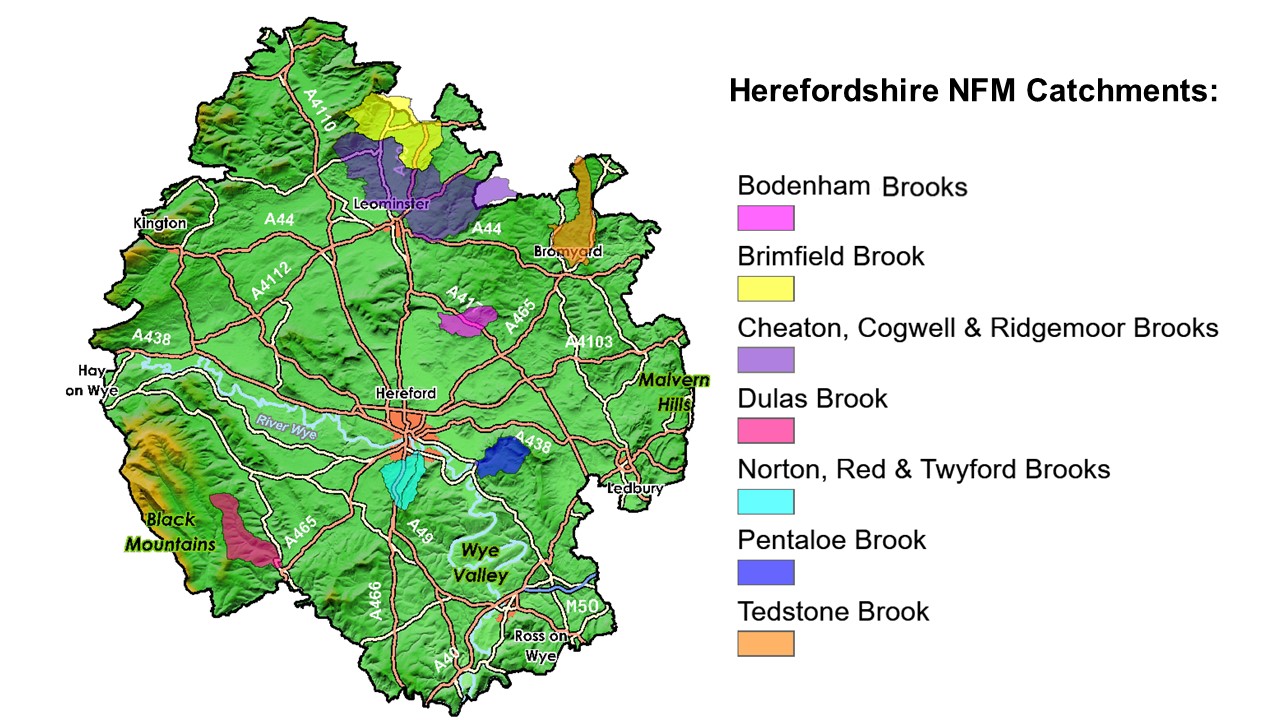Herefordshire Natural Flood Management (NFM) Project
Working with nature to reduce the risk of flooding for communities
Herefordshire Council has secured Flood and Coastal Risk Management funding which will enable us to continue to engage with numerous landowners and deliver a wide variety of NFM measures within seven priority sub-catchments until 31 March 2027:
- Bodenham Brooks (above Bodenham)
- Brimfield Brook (above Brimfield and Orleton)
- Cheaton, Cogwell and Ridgemoor Brook system (above Leominster and Frome)
- Dulas Brook (above Ewyas Harold)
- Pentaloe Brook (above Mordiford)
- Tedstone Brook (above Bromyard)
- Red, Norton and Twyford Brook system (above Rotherwas, Hereford)
You can also see these sub-catchments on a map of Herefordshire below.

Our project focuses on natural processes and land management measures to both slow the flow of water and store the water within upland areas in order to reduce the risk of flooding to downstream communities. Techniques include:
- Increasing infiltration into the soils: By adopting better soil management techniques such as contour ploughing and planting cover crops, it is possible to improve the soil structure and organic matter content of the soils. This helps increase the amount of water soaking into the soils, meaning it takes longer for the water to reach the watercourse;
- Slowing the flow of water: By creating features which obstruct flow across the river channel or floodplain, for example "leaky dams", it is possible to hold back water associated with higher flows. This results in lower flood levels downstream of the features; and
- Storing water upstream: Water can be stored within the upstream catchment and released slowly. This can be done by using existing storage areas and by creating new ponds, wetland areas or below-ground temporary water storage (attenuation) basins.
To find out more about NFM and to learn more about the monitoring and evaluation of NFM catchment and community projects all across the UK:
Find out more about what was delivered through our NFM pilot project.
Grants and funding for Natural Flood Management
Grants for landowners and farmers within the seven priority sub-catchments are available to support changes to land and water management practices that reduce flood risk.
If you are interested in doing some NFM on your land or if you would like free specialist advice from catchment advisors at the Wye and Usk Foundation or Severn Rivers Trust contact us using the details on this page.
NFM consents flowchart
Our NFM consents flowchart details the required procedures and possible approvals for NFM measures such as the requirement for planning permission and other statutory approvals. We can email this to you on request.
Request NFM consents flowchart
Find out more about the NFM grant scheme and how to apply
Other funding sources for NFM delivery in Herefordshire include:
- Farming in Protected Landscapes Grant Scheme - Wye Valley National Landscape
- Mid-Tier Countryside Stewardship
Benefits for people and for the environment
As well as reducing flood risk, NFM measures can deliver benefits for both people and the environment. For example, NFM can help improve water quality, biodiversity and resilience to climate change. Soil management techniques can also help reduce soil erosion, having benefits for agricultural businesses.
To help deliver our project, Herefordshire Council will work in partnership with the Environment Agency, Local Flood Groups, local communities and other key delivery partners.
Any opportunities to continue our work on NFM or to work within other areas of Herefordshire will be identified and considered, subject to being able to secure additional funding.
